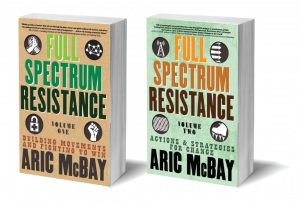We fight because it works. We know it works because of the dozens of nations that have successfully expelled dictators or colonizers over the past half-century. We know because women in most of the world can own property, vote, and conduct their own affairs. We know because slavery has been largely wiped out in the Americas.36 We know because workers in much of the world have the right to form unions and to the eight-hour workday.
Gaetan Heroux of the Ontario Coalition Against Poverty told me: “Poor people will never, ever, get the basis of what they need to live unless they fight for it. Because that’s how it was won. They won’t give it to us by quiet, polite meetings. It was never won like that.”
Consider the Suffragists. In the late nineteenth century, women in England lobbied hard for the right to vote. But their polite requests for equal rights were ignored by parliament for decades. It wasn’t until a second generation of suffragists came to the fore and escalated their tactics that the government was forced to pay attention. The suffragists fought hard with civil disobedience, property destruction, and arson. Thousands of militant women went to prison, where they faced isolation and abuse. But in the end, their campaign succeeded; women won the vote in England, and soon in many other countries as well.
Resistance groups often go after the economy. In Nigeria, the Movement for the Emancipation of the Niger Delta has targeted oil infrastructure and on more than one occasion forced a 70 percent decrease in oil output.37 From the Boston Tea Party to the Montgomery Bus Boycott to the African National Congress, resistance struggles have gone after the economies of the ruling class because it is so incredibly effective.
It’s time for us to move from dissidence to resistance. As the cofounder of the suffragist Women’s Social and Political Union, Christabel Pankhurst, wrote: “We know that relying solely on argument we wandered for forty years politically in the wilderness. We know that arguments are not enough . . . and that political force is necessary.”
Or as the civil rights song went: “The only thing we did was wrong / staying in the wilderness too long. . . . I know the one thing we did right / was the day we started to fight.”
In this book I will show how resistance movements form and organize in practical terms. How and why people join movements and how to encourage that process (chapter 4). How groups form and organize themselves to be as effective and safe as possible whether they are organizing aboveground or underground (chapter 5). The rules and practices they use to stay secure, to protect themselves, and to limit infiltration and repression by prosecution (chapter 6).
I will illustrate how people and groups communicate and stay connected so that they can spread their message, coordinate with allies, and navigate their relationship with the mass media (chapter 7). How organizations gather the intelligence and information they need to make smart decisions and understand their adversary’s weak points (chapter 8). And how resistance movements hamper their opponent’s attempts to gather that information about them, and how they cope with attacks on their movement through secret disruption or overt repression (chapter 9).
I will discuss how they raise money, how they support themselves, and how they organize the fundamental logistics that underpin any long-term struggle (chapter 10).
The closing chapters of the book will discuss how those movements take effective action through their tactics (chapter 11) and the principles that guide successful strategy and allow movements to integrate these different capacities (chapter 12).
But before we can get to those practicalities, we must have a better understanding of what makes a movement work.38 We must understand what it means to fight to win, and why we have been held back. And we must understand how to deploy the full range of appropriate tactics we have available.
It’s time to stop wandering in the political wilderness. This book is about fighting—and winning.
Get the bookFor endnotes, see full book.


